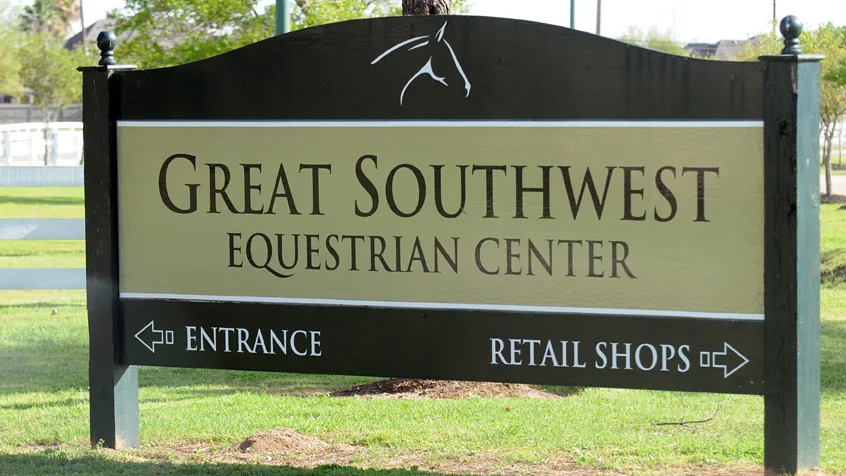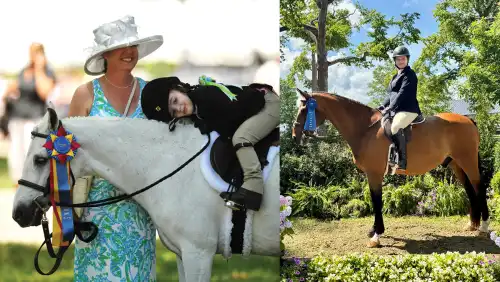With U.S. Equestrian Federation-recognized shows set to begin again on June 1, many equestrians are wondering what the new normal will look like. Britt McCormick attended the F C Schooling Show at Great Southwest Equestrian Center in Katy, Texas, held May 7-10, and had a positive experience with the new procedures and policies in place.
The show started the same day that USEF officials released their Licensed Competitions COVID-19 Toolkit, which features the USEF Action Plan outlining mandatory requirements and recommended best practices for competition organizers and participants. According to McCormick, who sits on the U.S. Hunter Jumper Association board of directors and the USEF National Hunter Committee, the show had independently designed policies and procedures that were largely in line with the USEF’s requirements and recommendations.
“You have to keep in mind who I am and where I’m from, being a Texan,” said McCormick, who runs Elmstead Farm in Parker, Texas, about 30 miles north of Dallas. “Our outlook on things is a little bit more leaning toward the economic side. We’re lucky in that our healthcare system in this state is phenomenal. We have tons of beds. All the doctors that ride with me say the same thing.”
Elmstead Farm has continued to run fairly normally, albeit with additional precautions, during the pandemic. The farm has been open with expanded hours and sign-up times for riders, with no more than eight on the property at any one time. McCormick removed crossties and shut down washracks that were directly next to one another at home to help keep his riders safe. He has one employee who spends her day walking around with a spray bottle and rag disinfecting pitchfork handles, stall doors, brushes—anything that’s being touched.
With no problems handling precautions at home, McCormick had few misgivings about heading to Great Southwest. When he arrived he was impressed with the signage across the showgrounds.
ADVERTISEMENT
“They had a piece of duct tape every six feet on any surface you could possibly stand or sit on,” he said. “It was on the pavilions by each ring and lining the rail of the jumper ring where everyone stands to watch. The signs were beautiful and professional, had pictures of masks, had protocols in the barns.”
The show set up handwashing stations and supplied hand sanitizer at multiple locations. There were spray bottles of disinfectant in the schooling rings for the jumps as well as gloves. Only trainers went to the show office, which they didn’t enter; there was a pick-up window, and there they gave you a fresh pen out of one box to sign any forms. Trainers deposited the pen into a “dirty” box after they signed. (The pens were sanitized and re-used.) But there was little reason to go to the show office since all entries and health papers were done online, and adds and scratches could be done online as well. McCormick said the office emailed him PDFs of his customers’ bills after he checked them out. Feed and bedding orders had to be completed before the show started.
“Every barn had their own aisle way,” said McCormick. “Let’s say for the sake of discussion that the stalls run north-south. The barn in aisle A would be on the north end, and the barn in aisle B would be on the south end. Even catty-cornering the barns aisle to aisle, which was great.”
Great Southwest has several indoor arenas, but during the F C Schooling Show everything was outdoors. The indoor arenas were shut down so people couldn’t go sit in there either. Juniors were limited to one parent apiece. The gates to the facility were closed, and when participants arrived they had to sign a release. Masks were required except while mounted, and two show officials, dubbed the “Covid Cops,” spent the entire time making sure everyone was wearing masks and social distancing.
“They were real serious about it,” said McCormick. “I had two teenage girls who refused to wear the masks, and he stayed on them like crazy.”
The show was originally slated to be a USEF national-rated horse show, and it was run as professionally as any USEF show, according to McCormick. He estimated there were 160 horses on the property.
ADVERTISEMENT
“Normal for there is probably 650-750,” he said. “I personally feel like more than 80-100 horses per ring per day will be about max, for an outdoor show with no lights. My guess is we were in 120 trips [per ring] a day. It is a slower process.”
Part of what slows down that process is the under saddle class. The show was limited to four people participating at one time, in show rings and schooling rings. So for under saddle classes riders hacked four at a time until all participants had a chance to go, with the judges awarding one set of ribbons. There were no presentations, and ribbons were distributed through the window of a ribbon room.
One way the show did diverge from the USEF recommendations is that there were not designated orders-of-go (outside of the hunter derby and the mini prix), which McCormick hypothesized was because of the size of the show, though there were check-ins. He said that it worked well to have the hunters running on a three-horse rotation. He didn’t think it would work to try to always have the same barn doing the three-horse rotation because most barns don’t bring enough horses to have three in a class.
Some participants did braid (McCormick elected not to have his eight horses braided), and no one jogged. The regular food stand wasn’t open, though the coffee shop was.
McCormick stayed in his camper (all the campers were spread out), and most of his customers stayed with nearby family, but two stayed in a hotel with no complaints.
McCormick said that in his opinion everyone needs to do what’s best for their individual situation. For example, his wife Rachel is sensitive to illness, so he’s staying in his camper for a week after returning home and checking his temperature to be extra careful not to bring something in. He elected to ship his horses himself rather than commercially, in part for financial reasons and in part to eliminate one layer of risk, and he’s adjusting his show schedule for the summer to avoid indoor venues.
“I think you have to be smart about making sure the industry stays alive, smart about maintaining the integrity of the sport and not start changing stuff too much, and be flexible where you need to be flexible,” he said. “There may be a different answer in every part of the country.”















